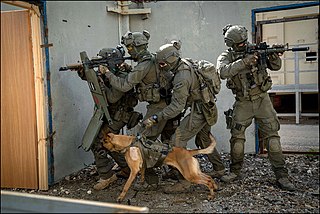Related Research Articles
Continuity of Operations (COOP) is a United States federal government initiative, required by U.S. Presidential Policy Directive 40 (PPD-40), to ensure that agencies are able to continue performance of essential functions under a broad range of circumstances. PPD-40 specifies certain requirements for continuity plan development, including the requirement that all federal executive branch departments and agencies develop an integrated, overlapping continuity capability, that supports the eight National Essential Functions (NEFs) described in the document.

The United States Department of Homeland Security (DHS) is the U.S. federal executive department responsible for public security, roughly comparable to the interior or home ministries of other countries. Its stated missions involve anti-terrorism, border security, immigration and customs, cyber security, and disaster prevention and management.

The Federal Emergency Management Agency (FEMA) is an agency of the United States Department of Homeland Security (DHS), initially created under President Jimmy Carter by Presidential Reorganization Plan No. 3 of 1978 and implemented by two Executive Orders on April 1, 1979. The agency's primary purpose is to coordinate the response to a disaster that has occurred in the United States and that overwhelms the resources of local and state authorities. The governor of the state in which the disaster occurs must declare a state of emergency and formally request from the President that FEMA and the federal government respond to the disaster. The only exception to the state's gubernatorial declaration requirement occurs when an emergency or disaster takes place on federal property or to a federal asset—for example, the 1995 bombing of the Alfred P. Murrah Federal Building in Oklahoma City, Oklahoma, or the Space Shuttle Columbia in the 2003 return-flight disaster.

Counterterrorism, also known as anti-terrorism, incorporates the practice, military tactics, techniques, and strategy that government, military, law enforcement, business, and intelligence agencies use to combat or prevent terrorism. Counter-terrorism strategy is a government's plan to use the instruments of national power to neutralize terrorists, their organizations, and their networks in order to render them incapable of using violence to instill fear and to coerce the government or its citizens to react in accordance with the terrorists' goals.

The Counterterrorism Division (CTD) is a division of the National Security Branch of the Federal Bureau of Investigation. CTD investigates terrorist threats inside the United States, provides information on terrorists outside the country, and tracks known terrorists worldwide. In the wake of the September 11, 2001 attacks, CTD's funding and manpower have significantly increased.

A National Special Security Event (NSSE) is an event of national or international significance deemed by the United States Department of Homeland Security (DHS) to be a potential target for terrorism or other criminal activity. These events have included summits of world leaders, meetings of international organizations, presidential nominating conventions and presidential inaugurations. NSSE designation requires federal agencies to provide full cooperation and support to ensure the safety and security of those participating in or otherwise attending the event, and the community within which the event takes place, and is typically limited to specific event sites for a specified time frame.

The National Cyber Security Division (NCSD) is a division of the Office of Cyber Security & Communications, within the United States Department of Homeland Security's Cybersecurity and Infrastructure Security Agency. Formed from the Critical Infrastructure Assurance Office, the National Infrastructure Protection Center, the Federal Computer Incident Response Center, and the National Communications System, NCSD opened on June 6, 2003. The NCSD mission is to collaborate with the private sector, government, military, and intelligence stakeholders to conduct risk assessments and mitigate vulnerabilities and threats to information technology assets and activities affecting the operation of the civilian government and private sector critical cyber infrastructures. NCSD also provides cyber threat and vulnerability analysis, early warning, and incident response assistance for public and private sector constituents. NCSD carries out the majority of DHS’ responsibilities under the Comprehensive National Cybersecurity Initiative. The FY 2011 budget request for NCSD is $378.744 million and includes 342 federal positions. The current director of the NCSD is John Streufert, former chief information security officer (CISO) for the United States Department of State, who assumed the position in January 2012.

The Homeland Security Act (HSA) of 2002, was introduced in the aftermath of the September 11 attacks and subsequent mailings of anthrax spores. The HSA was cosponsored by 118 members of Congress. The act passed the U.S. Senate by a vote of 90–9, with one Senator not voting. It was signed into law by President George W. Bush in November 2002.

Critical infrastructure protection (CIP) is a concept that relates to the preparedness and response to serious incidents that involve the critical infrastructure of a region or nation.
The counter-terrorism page primarily deals with special police or military organizations that carry out arrest or direct combat with terrorists. This page deals with the other aspects of counter-terrorism:
The California Governor's Office of Emergency Services is a California cabinet-level office responsible for overseeing and coordinating emergency preparedness, response, recovery and homeland security activities within the state. The agency was created by AB 38 (2008), superseding both the Office of Emergency Services (OES) and Office of Homeland Security (OHS).
The United States National Strategy for Homeland Security is a formal government response to the events of September 11, 2001 at the Pentagon and World Trade Center. The document issued by President George W. Bush outlines the overall strategic considerations for cooperation between the federal government, states, private enterprises, and ordinary citizens in anticipating future terrorism attacks as well as natural disasters and other incidents of national significance. The National Response Framework is the part of the homeland security national strategy that is a Comprehensive Emergency Management guideline for implementing scalable responses to disasters and other incidents of national significance.
HSPD-7 was revoked by the Presidential Policy Directive 21 (PPD-21) on Critical Infrastructurepp Security and Resilience on February 12, 2013. PPD-21 states that "Plans developed pursuant to HSPD-7 shall remain in effect until specifically revoked or superseded." Multiple changes came out of PPD-21, including a six actions with specific deadlines. One of those actions was to update the National Infrastructure Protection Plan within 240 days.
Homeland Security Presidential Directive (HSPD)-8, National Preparedness, describes the way United States Federal agencies will prepare for an incident. It requires Department of Homeland Security to coordinate with other Federal agencies and with State, local, and Tribal governments to develop a National Preparedness Goal with Emergency management. Congressional laws enacted, following the wake of 9/11, which resulted in new developments in the way security was assessed and addressed in the United States, to prevent and respond to threatened or actual domestic terrorist attacks, disasters, and other emergencies by requiring a national domestic all-hazards preparedness goal. HSPD 5, HSPD-7, HSPD-8, and HSPD-8 Annex 1 are directives that deal with the preparedness goals.
A Weapon of mass destruction Civil Support Team supports civil authorities in the event of the use, or threatened use, of a weapon of mass destruction. CSTs are federally funded units established under Presidential Decision Directive 39. There are 57 National Guard Teams and one Army Reserve full-time team: one in every U.S. state, Washington, D.C., Puerto Rico, Germany, Guam, and the US Virgin Islands with an additional team each in California, Florida, and New York.

The Deployable Operations Group (DOG) was a United States Coast Guard command that provided properly equipped, trained and organized Deployable Specialized Forces (DSF), which still exist today, to the Coast Guard, United States Department of Homeland Security (DHS), United States Department of Defense (DoD) and inter-agency operational and tactical commanders. Formerly headquartered in Arlington, Virginia, it was established on 20 July 2007, and was commanded by a captain and was decommissioned by the Commandant of the Coast Guard, Admiral Robert Papp on 1 October 2013, although many of the units existed long before the 2007 commissioning. Upon decommissioning, the units previously assigned to the DOG were split between Coast Guard Pacific and Atlantic Area commands.
The Domestic Emergency Support Team (DEST) is a rapidly deployable, interagency team of experts within the United States government, staffed from the Federal Bureau of Investigation (FBI), the Federal Emergency Management Agency (FEMA), the Department of Defense (DoD), the Department of Energy (DOE), the Department of Health and Human Services (HHS), and the Environmental Protection Agency (EPA). The DEST provides guidance to the FBI Special Agent in Charge (SAC) concerning weapons of mass destruction (WMD) threats and actual incidents/attacks.

Homeland Security Grant Program (HSGP) is a program in the United States established in 2003 and was designated to incorporate all projects that provide funding to local, state, and Federal government agencies by the Department of Homeland Security. The purpose of the grants is to purchase surveillance equipment, weapons, and advanced training for law enforcement personnel in order to heighten security. The HSGP helps fulfill one of the core missions of the Department of Homeland Security by enhancing the country's ability to prepare for, prevent, respond to and recover from potential attacks and other hazards. The HSGP is one of the main mechanisms in funding the creation and maintenance of national preparedness, which refers to the establishment of plans, procedures, policies, training, and equipment at the Federal, State, and local level that is needed to maximize the ability to prevent, respond to, and recover from major events such as terrorist attacks, major disasters, and other emergencies. The HSGP's creation stemmed from the consolidation of six original projects that were previously funded by the Office of State and Local Government Coordination and Preparedness. The HSGP now encompasses five projects in the program: State Homeland Security Program, Urban Areas Security Initiative, Operation Stonegarden, Metropolitan Medical Response System Program, and Citizen Corps Program. During the 2010 fiscal year, the Department of Homeland Security will spend $1,786,359,956 on the Homeland Security Grant Program.

National Response Scenario Number One is the United States federal government's planned response to a nuclear attack. It is one of the National Response Scenarios developed by the United States Department of Homeland Security, considered the most likely of fifteen emergency scenarios to impact the United States. The Scenarios are related to the National Response Framework (NRF), which describes the structures and mechanisms of a response and the National Incident Management System (NIMS) that gives a framework to orchestrate emergency management.
The UN Counter-Terrorism Implementation Task Force (CTITF) was an instrument designed to roll out the UN Global Counter-Terrorism Strategy.
References
- 1 2 3 4 5 "COMBATING TERRORISM: PRESIDENTIAL DECISION DIRECTIVE 62". White House Office of the Press Secretary . May 22, 1998. Archived from the original on 25 November 2016.
- ↑ "Presidential Decision Directive-62 (PDD-62), "Protection Against Unconventional Threats to the Homeland and Americans Overseas,"".
- 1 2 3 4 5 6 "COMBATING TERRORISM (PDD 62)". fas.org.